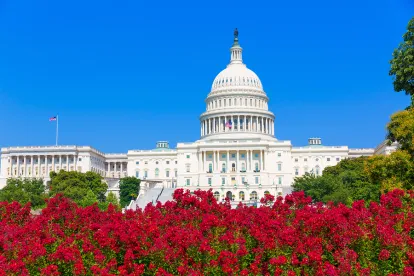Yesterday, the House of Representatives passed H.R. 4447, the Clean Economy Jobs and Innovation Act , by a vote of 220-185. The legislation combines a series of bills that would authorize new research, development, and demonstration (RD&D) initiatives at the Department of Energy (DOE) across each of DOE’s applied energy research programs and authorize new funding for electric vehicle (EV) infrastructure, energy efficiency programs, electric grid modernization, and environmental justice programs. Notably, the bill also includes a phasedown of the production and consumption of hydrofluorocarbons (HFCs), a top legislative priority for House Energy and Commerce Committee Democratic leadership this year.
The Clean Economy Jobs and Innovation Act supports the objectives of Congressional Democrats to implement policy achieving economy-wide net-zero emissions by 2050. The bill focuses on investing in clean energy innovation programs and setting up a foundation upon which future energy and climate legislation could be built. House Energy and Commerce Committee Chairman Frank Pallone (D-NJ) called the bill a “down payment” in the fight against climate change. It is notable that the bill does not include any broad economy- or electric sector-wide emissions reduction policies or regulatory mandates that were a major feature of the draft CLEAN Future Act legislation or H.R. 2, the Moving Forward Act that were considered earlier this year.
The legislation is a work product of three House Committees – the Energy and Commerce Committee, the Natural Resources Committee, and the Science, Space, and Technology Committee. The Energy and Commerce and House Natural Resources Committees included bills in the package that were included in previous legislation that focused on authorizing funding for clean energy and EV infrastructure and deploying renewable energy on public lands. The Science, Space, and Technology Committee, which has jurisdiction over all federal non-defense research and development activities, included a suite of legislation it has developed throughout the 116th Congress to reauthorize and create new RD&D programs focused on:
- Solar energy
- Wind energy
- Geothermal energy
- Water power
- Carbon capture, utilization, and storage (CCUS)
- Nuclear energy
- Electric grid modernization
- Energy storage
- Electric grid security
- Industrial emissions technologies
- Critical materials
The bill also authorizes increased funding for the Advanced Research Projects Agency-Energy (ARPA-E) and incorporated an amendment from Rep. Kathy Castor (D-FL) to add emissions reduction and climate change mitigation to DOE’s research and development mission. Much of the legislation that was included in the Clean Economy Jobs and Innovation Act was also recommended in the House Select Committee on the Climate Crisis’ majority staff report released on June 30.
Outlook
While it was understood that previously released sector- and economy-wide legislative proposals on energy and climate were not likely to be enacted during this Congress, the Clean Economy Jobs and Innovation Act was developed and managed with the intent to negotiate differences with a Senate energy bill in a conference committee this year. Specifically, many provisions included in the House bill are aligned with S. 2657, the American Energy Innovation Act, which similarly focuses on modernizing and authorizing new funding for RD&D programs at DOE. Despite these efforts, policy and politics may be an obstacle for further action.
Legislative language included in the House bill from the Energy and Commerce and Natural Resources Committees, along with amendments incorporated by the House Rules Committee, bring the bill slightly out of line with its Senate counterpart and may complicate a potential conference negotiation. Examples of non-analogous provisions include authorizations for EV infrastructure, environmental justice measures, and an amendment that would reinstate methane regulations put into place under the Obama Administration. The White House has also issued a Statement of Administration Policy (SAP) citing the Administration’s opposition to the bill’s funding levels and stating that it would undermine the Administration’s deregulatory agenda. The SAP further complicates the outlook for a conferenced energy bill that authorizes significant funding for energy RD&D programs.
Senate Energy and Natural Resources Committee Chairwoman Lisa Murkowski (R-AK) continues to seek floor consideration for the American Energy Innovation Act with the hopes of conferencing the bill with the House-passed measure. Chairwoman Murkowski was able to broker a resolution related to the phasedown of HFCs and building energy efficiency provisions that have prevented floor consideration, but several Senators are still have holds on the bill, preventing it from reaching the Senate floor. Consideration of the Senate bill is also likely to be impacted by the nomination of a successor for the late Supreme Court Justice Ruth Bader Ginsburg.
With the passage of the Clean Economy Jobs and Innovation Act in the House, Congress could move to a conference negotiation on an energy bill after the election if Chairwoman Murkowski is able to secure floor time for the Senate bill. However, the combination of electoral politics and the Supreme Court nomination process prior to the November elections, and the need to address federal appropriations for Fiscal Year 2021 and a possible COVID-19 stimulus package may diminish the political will required to move an energy package this year.




 />i
/>i
